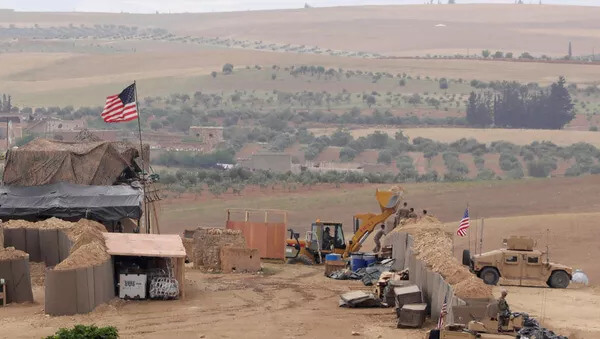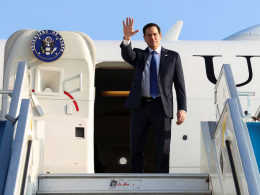United States intelligence officials revealed through leaked documents Thursday that the Islamic Republic of Iran is arming militants in Syria for a new phase of deadly attacks against American troops while working with Russia to drive US influence from the region.
According to classified intelligence reports, Tehran and its regional allies are creating and training forces to use powerful armor-piercing roadside bombs to target American military vehicles and kill US personnel.
Officials say such attacks are not new, given Tehran's long-running campaign of using proxy militias to launch rocket and drone strikes on US forces in Syria.
Information from another classified intelligence document reveals new efforts by Moscow, Damascus, and Tehran to push the U.S. from Syria, allowing Syrian President Bashar al-Assad to reconquer eastern Syrian provinces currently controlled by US-backed Kurdish forces.
"Iran has been waging a shadow war against the United States since the Iranian Revolution of 1979, aimed at kicking the US out of the Middle East, diminishing America's power and reach by either subordinating or reducing rival local powers (such as the Sunni Arab States as led by Saudi Arabia and Israel), and augmenting their own power by aligning closely with China and Russia, America's two principal rivals on the world stage," said Brandon Weichert, author of the forthcoming book The Shadow War; Iran's Quest for Supremacy and senior editor of 19FortyFive.com.
Islamic Republic officials directed and oversaw the development of a new military explosive, which penetrated a tank's armored plating in an experiment run in late January in Ad Dumayr, near the Syrian capital of Damascus. The classified reports revealed communications by Syrian and Lebanese militia groups affiliated with Tehran to use such weaponry against American forces. Last February, US-backed Kurdish fighters seized three bombs in the northeastern province of Syria aimed at US soldiers.
According to Weichert, Iran cannot match the US military in a fair fight and instead has embraced "asymmetrical warfare and the use of terror tactics to kill Americans in Syria is one of the methods, along with others (such as deploying drones and precision-guided munitions to Lebanon and, until recently, Yemen), that are designed to weaken and push out the Americans to give Iran the kind of space it needs to build its own sphere of influence in the region."
The classified documents revealed wide-ranging campaigns by Tehran and Moscow, including support for armed resistance and grass-roots movements to attack American troops in eastern and northeastern Syria.
According to intelligence officials, senior-ranking Russian, Iranian, and Syrian military and intelligence officials met in November last year and agreed to establish a "coordination center" for directing the campaign.
While the classified documents did not indicate direct Russian involvement in planning the bombing campaign against American soldiers, they did reveal a more active role by Russia in a broader anti-American effort.
"They've been at this plan for decades, and it is now working. Expect more of this. If the Biden Administration foolishly embraces the nuclear deal with Iran that former President Barack Obama created in 2015 and that his successor, Donald J. Trump, smartly pulled out of, then Biden will basically be giving Iran the green light to take the region--and develop sophisticated nuclear weapons with which to reinforce their claims of the supremacy of the Middle East," Weichert told The Foreign Desk.
Another leaked document described revealed efforts by a bomb maker with the Iranian-backed Lebanese Shiite terrorist group, Hezbollah, to conduct and assess a new type of Explosively Formed Penetrator (EFP) in Syria in January of this year. The newly created explosive device measured just under five inches in diameter and was well-built and "concealable" because of its small size and payload of 3.3 pounds of C-4 military explosive.
Following several tests, the bomb's projectile destroyed around three-inch-thick tank armor at a 75 feet range, according to the classified report.
The report noted that the Islamic Republic of Iran's Revolutionary Guards Corps (IRGC) Quds Force helped create the bomb's design and operational plans to use it. One Quds Force official singled out was Sadegh Omidzadeh, who "identified us Humvee and Cougar armored vehicles in Syria" as the intended targets and talked of placing unidentified operatives to take reconnaissance photographs of roads traveled by American forces.
A different classified document outlined how Kurdish fighters seized several EFPS and said that such explosive devices were being sent by a Syrian Quds Force "associate" in preparation for an "eventual attack on US forces" in the northeastern area of Rumeilan. Experts familiar with Iran and Russia's activities in Iran say that the new military efforts will find support among Arab populations that are against American forces in Syria and Kurdish rule in eastern and northeastern Syria.
Following the Syrian uprising in 2011, the Islamic Republic of Iran and Russia came to the Assad government's rescue, deploying Russian soldiers and IRGC troops to aid the Syrian army in their brutal repression of Syrians who were calling for the resignation of the Assad regime and a new Syrian government that would respect the rights of all citizens.
"Make no mistake: the Middle East is no longer America's most important zone of strategic interest. Yet, simply walking away from the region and leaving it to a nuclear-arming Iran (and therefore Iranian partners in Beijing and Moscow) is the best way to ensure that the US is fundamentally--forever, even--weakened on the world stage," Weichert said.
Since the Obama presidency, the US has maintained a small contingent of 900 troops and several hundred contractors in Syria to prevent the reappearance of Islamic State and Al Qaeda militants. Over the years, the US has also thwarted Tehran and Moscow's military ambitions in the region, targeting Iranian-backed proxy groups and engaging in intelligence operations to assist allies, including Israel and Saudi Arabia.
Despite American forces in Syria, Russia and Iran continue to engage in illegal arms smuggling and terrorist financing, resulting in the deaths and injuries of American troops in the region and US-backed Kurdish fighters. As a result of the support Damascus has received from Tehran, Israel has launched various aerial attacks against Iranian forces in Syria, destroying arms shipments and top-level IRGC commanders who have been active in targeting Israeli and American troops in the Middle East.
Experts like Weichert note that the Middle East is and always has been the "crossroads of civilization" and a "key component of the global energy trade. With America's outsized role there, Washington was able to have great leverage over the rest of the world." He added that if America hands the region to Iran and leaves weakened partners there, "nothing good for the US will come of it."
Related Story: 17 Islamic Republic “Ghost Tankers” Transporting $1 Billion in Oil to Syria










